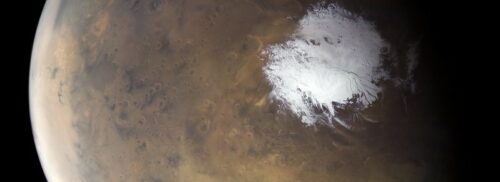Image Courtesy of Flickr.
Scientists have been searching for liquid water on Mars for decades. It’s one of the most vital materials for future human inhabitation of the red planet and could harbor yet unknown Martian life. A groundbreaking paper published in 2018 by Orosei and others claimed that liquid water had finally been detected under the South Polar Layered Deposits (SPLD), the Martian equivalent of the Antarctic ice cap on Earth. The study analyzed radar data from the Mars Express Orbiter’s Advanced Radar for Subsurface and Ionosphere Sounding (MARSIS) instrument, concluding that a briny layer of liquid water was responsible for significant radar reflections at the base of the SPLD. Later geophysical work, including modeling mantle heat flow under the SPLD, called this result into question based on the excessive heat requisite for a liquid layer to form. In September 2022, a paper published in Nature provided a plausible alternative explanation for the data initially interpreted as signs of liquid water. “Unfortunately, I kind of feel like the Grinch a little bit, where I have to come in and say, ‘That’d be cool and all, but I don’t think that’s what’s happening’,” lead author Daniel Lalich said.
In the paper, authors Daniel Lalich, Alexander Hayes, and Valerio Poggiali of Cornell University used computer-simulated radar models to demonstrate that the SPLD radar data collected by MARSIS could be reproduced without a liquid water layer. Instead, the study found that constructive radar wave interference could yield the same return data as a layer of liquid water. “It does seem like it would be unlikely, but we know it happens in other places,” Lalich said.
The SPLD is an ice cap over one kilometer thick composed primarily of dusty ice. Layered on and within the deposits are also meter-thick slabs of carbon dioxide (CO2) ice. As CO2 ice and water ice have different chemical and physical properties, they interact with radar waves slightly differently. Lalich demonstrated that layered CO2 and water ice within a simply modeled SPLD can result in interference and amplification of the radar return at the bottom of the deposits to the same extent observed in the MARSIS data. “It’s actually fairly easy to generate constructive interference given what we think the conditions are in the South Pole,” Lalich said.
This result is important as it provides an alternative explanation for the observed data using only well-known material parameters from the SPLD, constituting a hypothesis more in line with prevailing geophysical models. “Even with geothermal heating, the temperature should still be way too low for there to be liquid water,” Lalich said. It also serves as a sign of caution for subsequent radar sounding studies of complex, layered features at not only the SPLD but across Mars. What this study does not do, however, is serve as definitive proof against the brine water hypothesis. “It’s easy to say that we can’t rule out interference, but that’s different from saying that it’s definitely what’s happening,” Lalich said. Subsequent arguments and closer examinations will undoubtedly continue, nudging us increasingly closer to elucidating the true nature of these intriguing, unexpected radar observations.

